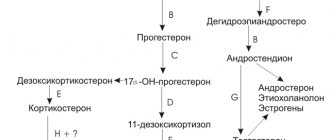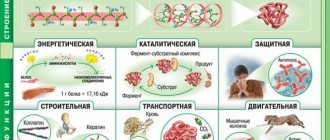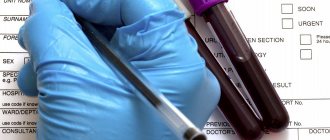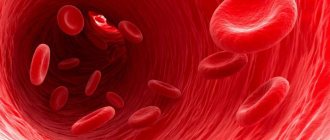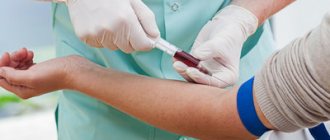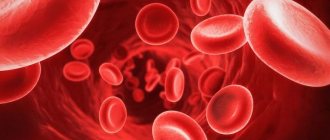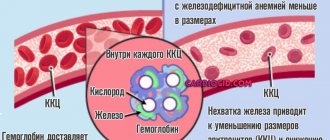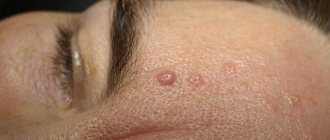Published: 05/29/2018 at 11:04
Category: Health
Tags: health
Often in medical practice, when conducting a laboratory examination, a biochemical blood test is prescribed, one of the indicators of which is rheumatoid factor. Its titers make it possible to determine not only pathologies of the locomotor system, but also the general health of the body, as well as identify dysfunctions of various systems and internal organs.
An elevated rheumatoid factor in the blood is detected. Based on the test results, the presence of pathological processes in the body is established. To accurately diagnose the disease, in addition to the rheumatic factor, an additional set of laboratory and hardware examinations is prescribed.
If rheumatoid factor is elevated, it can be fatal. Since many pathologies, a symptom of which are its elevated titers, affect the cardiovascular system, which can cause sudden death. To stabilize the level of RF in the blood, it is necessary first of all to eliminate the reasons that provoked its increase.
What is rheumatic factor?
Rheumofactor is a modified protein of antiglobulin autoantibodies of classes M, A, G, E, D, under the influence of constant viral, microbial, fungal or physical factors. The latter include cold, radiation, poisoning with pesticides, constant exposure to an area of increased ultraviolet background, plus the consumption of foods rich in group E preservatives in a nutritious diet. Antibodies are directed towards the elimination of one’s own healthy cells or to one’s own type G immunoglobulins. This type is produced in the synovial fluid, Then it enters the bloodstream, where it combines with other immune components to form aggressive complexes. They directly and purposefully act on collagen, damaging all tissues containing it.
The rheumatoid index is a substance of protein origin, which, having changed, perceives connective tissue as a foreign protein. At the very beginning of the disease in rheumatoid-type arthritis, disease-specific immunoglobulins M are found only in the articular components. In the chronic course of the pathology, a specific factor is also produced by other organs (spleen, lymph nodes, bone marrow, skin, cardiac tissue). In laboratory tests of blood serum, synovial fluid and histological sections of tissue, a certain amount of immunoglobulins is detected. Their titer depends on the stage of the disease and on concomitant pathologies.
Attention! If you are not examined when the first symptoms of pathology appear, aggression of the immune system will lead to irreversible processes in the internal organs + systems and to death.
Reasons for the increase in RF
Most often, an increase in rheumatoid factor is observed against the background of the following disorders:
- development of rheumatoid arthritis (diagnosed in 70% of cases in patients with elevated RF);
- inflammatory processes in connective tissues;
- systemic scleroderma (complex damage to connective tissue and internal organs);
- diseases of the lungs, liver and kidneys that are inflammatory in nature;
- sarcaidosis, silicosis, anthracosis;
- severe infectious diseases, such as malaria or tuberculosis;
- malignant neoplasms of the bone marrow.
If a dangerous disease is suspected, even if the result is negative, the doctor prescribes repeat testing after 3 weeks.
If rheumatoid factor is elevated in a child, this is not always a cause for concern. As medical practice shows, such a reaction is often diagnosed in children who constantly suffer from acute respiratory viral infections.
The ability of immune complexes to cause damage to the synovial membrane leads to further inflammation in the joint tissues and their destruction. This condition resembles a vicious cycle, which ultimately ends in degenerative changes in the joints, disruption of their function, limitation of joint mobility and disability of the patient.
Damage to the walls of blood vessels by immune complexes can cause diseases such as scleroderma, dermatomyositis, Sjogren's syndrome, and others. Rheumatoid factor is most often elevated in patients with rheumatoid arthritis and Sjögren's disease. It is detected in them in 60-70% of cases, so blood is taken from their veins for rheumatic tests. Rheumatic tests are also prescribed if rheumatic inflammation in other tissues is suspected (rheumatic myocarditis, endocarditis).
Rheumatic tests are laboratory tests that determine the inflammatory process in connective tissue. Analysis for rheumatoid tests mainly includes the determination of rheumatoid factor, C reactive protein and antistreptolysin-O. Rheumatic tests make it possible to identify the inflammatory process, its activity and, in some cases, the causative agent of the disease.
C reactive protein rheumatic test is an indicator of the activity of the inflammatory process and tissue destruction. It can also be detected in diseases associated with tissue necrosis, for example, during a heart attack. Antistreptolysin-O in the blood indicates the presence of an infectious lesion with streptococci. In addition to rheumatoid arthritis, it can also be determined by glomerulonephritis.
What is the norm for men and women?
All healthy people do not have rheumatoid factor, unless the person suffers from latent sexually transmitted diseases. Normal values like other laboratory data do not exist, which means that the factor is not in the blood or it is present and is considered positive. In the initial stages of rheumatism, the norm varies from 0 to 14 IU/ml (or 0 to 10 U/ml). These numbers differ by gender, with women being lower and men being higher.
| In men | Among women |
| 0 - 14ME/ml (0 - 10U/ml) | 0 - 13ME/ml (0 - 9U/ml) |
There are some nuances that are specific to each gender, namely, for men, the norm never varies, it is always within these limits. Women tend to change these indicators due to pregnancy, the menstrual cycle, and ovulation. Women's diseases such as adnexitis, endometritis, cervical erosion, cervicitis, can contribute to an increase in IgM titer in laboratory parameters. After drug therapy, antibodies disappear.
Important! Women are recommended to be tested more often for rheumatic factor to exclude systemic diseases such as systemic lupus erythematosus, Sjögren's syndrome, psoriasis and gastrointestinal diseases.
According to statistical data and during random examinations, an increased titer of C-reactive protein was detected in patients who abuse tobacco smoking and alcoholic beverages. In drug addicts and AIDS patients, these indicators are quite high, which indicates an autoimmune reaction of the body to its own tissues. Frequent allergic reactions to foods, chemicals or organic substances lead to changes in immune reactions towards the destruction of one’s own tissues.
The significance of the increase in the diagnosis of cardiovascular diseases
It should be noted that changes in RF titer cannot serve as the only diagnostic sign of any pathology. In such cases, the doctor refers the patient for additional studies, which are designed to identify the disease with great accuracy.
Most dysfunctions of the cardiovascular system, which are accompanied by increased rheumatoid factor in the blood, are a consequence of rheumatoid arthritis (with this disease, RF increases most often). These include:
Pericarditis. In the case of acute pericarditis, the patient feels pain in the sternum, radiating to the back and left shoulder; swelling of the legs and tachycardia may be observed.
A blood test reveals an increased level of RF, a high ESR in the blood (55 mm/h or more), and in the presence of pericardial exudate (exudative pericarditis), a high content of LHD and protein in combination with a low glucose level.
- Rheumatic myocarditis. The pathology is associated with extra-articular manifestations, high levels of RF, antinuclear antibodies and symptoms of systemic vasculitis.
- Heart defects . With a long course of erosive rheumatoid arthritis, patients may develop rheumatic heart defects. Usually they occur without any clinical manifestations, and the main signs in this case are extra-articular manifestations and a high titer of this indicator.
RF is also detected in patients with subacute infective endocarditis - in addition to this indicator, dysproteinemia, a decrease in albumin, and an increase in the content of G and G2 globulins are observed in this case.
Criteria for assessing rheumatic factor
Patients with rheumatism (or rheumatoid arthritis), depending on the stage of the disease, have different levels of C-reactive protein (IgM immunoglobulin). In the initial stage of the RF criteria, the indicators are exactly 14-15ME/ml, in subsequent stages these figures are high and stable. In addition to rheumatism, the criteria for increasing or decreasing the rheumatoid indicator are influenced by many somatic diseases, as well as the therapeutic measures taken.
Evaluation criterion RF:
- moderate increase: 25-50IU/ml;
- high titer: 50-100IU/ml;
- extremely high titer: 100IU/ml and above.
Performing a latex test (determining the presence or absence of rheumatoid factor), Waaler-Rose tests are based on measuring antigen-antibody complexes. To determine the groups of autoantibodies, an enzyme-linked immunosorbent test is performed in the blood. These laboratory tests are recommended for all patients with suspected RF. Laboratory studies determine the stage of pathology and the degree of damage to organs and systems as a whole, as well as specific treatment tactics.
Reasons for the increase
The rheumatoid index increases due to pathologies of the locomotor system, especially the ligamentous and lubrication apparatus. Other causes such as Sjögren's syndrome, gonorrhea, syphilis, tuberculosis, hepatitis, glomerulonephritis, urolithiasis, endocrine pathologies, cancer, as well as systemic skin diseases are reasons for increased RF. Inflammatory pathologies in the cardiac vascular system, plus all infectious diseases of the gastrointestinal tract, lead to upward changes in rheumatic factor indicators. Intoxication of any etiology is also the cause of increased RF.
Reasons for the downgrade
After a thorough laboratory + instrumental examination, patients are prescribed an individual treatment regimen. Carrying out a full course of medical therapy will reduce the rates of autoimmune aggression, and the rheumatoid factor will reach normal. That is, the immune system is regulated, aggression stops, and normal helpers begin to understand their own and foreign cells. The production of antibodies stops, the inflammatory-infectious reaction is eliminated.
In what cases is analysis prescribed?
Reasons for conducting research may be:
- aching pain in the joints;
- swelling of the joints;
- pain in the muscles;
- an increase in body temperature that lasts more than two weeks;
- severe headaches that are difficult to relieve with medications;
- rash localized on the skin of the face or hands;
- suspicion of systemic diseases;
- determining the effectiveness of treatment for rheumatoid arthritis.
Rheumatoid factor in a blood test, in most cases, means a serious pathology, so consultation with a rheumatologist and immunologist is necessary. It is better to entrust the interpretation of the results to a specialist.
Before answering the question, let's determine what level of rheumatoid factor is considered normal.
According to population standards, the normal concentration of rheumatoid factor varies from 0 to 20 IU/ml, regardless of the sex of the subject. The normal content of rheumatoid factor in women and men is absolutely identical. The maximum permissible value is 25 IU/ml. However, when assessing the level of RF, it is necessary to take into account the age of the subject.
Concentrations above 50 IU/ml are called moderately elevated. An increase in rheumatoid factor serves as a signal for doctors indicating the presence of autoimmune inflammation or another chronic process in the body. First of all, you need to make sure that the elevated RF readings are true and not a laboratory error.
To clarify, methods are used to qualitatively assess the content of rheumatoid factor (nephelometric analysis or ELISA). In addition to repeated examination for RF, a test for c-reactive protein (CRP), which is also considered a marker of autoimmune inflammation, is often done. The results of a laboratory examination by themselves are not a sufficient reason for making a diagnosis, so the doctor combines them with other diagnostic methods (questioning the patient, visual examination, radiography and other methods required for a particular case).
RF concentrations exceeding 100 IU/ml are assessed as high. Significantly elevated levels are a sign of an active autoimmune process. A RF level above 100 IU/ml signals disease progression and poor prognosis. The most likely cause of high numbers is rheumatoid arthritis, but this is not the only disease that has this symptom.
A slight increase in the described parameter should not cause concern. Sometimes it is caused by improper preparation for taking a blood test, physical fatigue, taking medications (contraceptives, muscle relaxants) and other external factors. In such cases, it is recommended to repeat the study.
There are circumstances when the presented indicator increases against the background of natural processes. In new young mothers and women who have recently undergone any surgical procedures, the number of protein immune complexes is higher than normal. Their volume is 2-3 times greater than the established values. This is a temporary phenomenon, and the blood composition stabilizes on its own.
When the concentration of autoantibodies is significantly higher, there is a likelihood of developing severe diseases and inflammatory processes. High rheumatoid factor is predominantly found in rheumatoid arthritis. This is a chronic, incurable pathology that affects the connective tissues in the body and small joints, especially in the fingers and toes. In what diseases is the rheumatic factor increased?
- Felty's syndrome;
- acute hepatitis;
- syphilis;
- tuberculosis;
- mononucleosis;
- Sjögren's syndrome;
- leprosy;
- flu and others.
If autoantibody values are positive and increased, the doctor will prescribe additional tests to clarify the diagnosis. If the rheumatoid factor in the blood test is significantly elevated, and the symptoms indicate the progression of arthritis, Felty's syndrome or Sjögren's syndrome, the following laboratory and instrumental tests are recommended:
- radiography of joints;
- ultrasound examination of connective and soft tissues;
- blood test for C-reactive protein.
After determining the exact diagnosis, individual complex therapy is developed. Most diseases in which the rheumatoid factor is elevated cannot be completely eliminated; treatment consists of stopping intense inflammatory processes, preventing their exacerbations, slowing down the destruction of joints and damage to connective tissues. For this we use:
- antibiotics;
- corticosteroid hormones;
- anti-inflammatory drugs.
Rheumatoid factor in a child
In childhood, a positive indicator of rheumatoid factor appears due to frequent acute respiratory viral infections, influenza or microbial infections of a staphylococcal-streptococcal nature. The antibody titer is 12.5 U/ml. After eliminating these causes, the RF reaches zero level. If the treatment does not bring a satisfactory effect and the RF is positive, then an autoimmune reaction is operating in the body.
In this case, the child needs to be thoroughly examined and treated in an inpatient setting by a rheumatologist. And also consult a small patient with an endocrinologist. Children over 13-15 years of age are at risk; puberty often leads to an increase in rheumatoid factor due to sudden jumps in sex hormones into the bloodstream.
Analysis transcript
The rate of the indicator in men and women varies depending on what provoked its increase. You can see what conditions can cause increased RF in special tables, but it is much wiser to entrust the decoding to a doctor.
| Indicator, IU/ml. | Possible pathology | Medical recommendations |
| 15–24 | First stage of rheumatism, ARVI, false positive reaction | Repeated testing is prescribed after 14 days, no treatment is provided. |
| 25–50 | Moderate autoimmune process: acute stage of syphilis or tuberculosis, rheumatic inflammation | A treatment regimen is prescribed only after identifying what caused the pathology |
| 51–100 | Severe connective tissue inflammation | Immediate treatment is required, which can be carried out both at home and in a hospital setting |
| Over 100 | Severe autoimmune processes indicating exacerbation of arthritis. This reaction is observed only in joint pathologies. | Requires immediate hospitalization |
Regardless of what caused the rise in rheumatoid factor, therapy is aimed at eliminating the original source of the pathology and improving the patient’s condition. Doctors usually prescribe complex therapy, which includes taking drugs from the following pharmaceutical categories:
- antibiotics;
- non-steroidal anti-inflammatory drugs;
- steroid hormones.
Therapy to lower the indicator is selected individually for each patient, taking into account the state of health and the type of lesion.
What does increased RF indicate?
The presence of RF in analyzes of synovial fluid, blood serum or in histological sections indicates the following pathologies:
- Rheumatism (rheumatoid arthritis): inflammatory process in certain groups of joints of the lower and upper extremities (phalanxes of the arms and legs, radial joint, ankle + knee joints). A seronegative result may occur at the first signs of the disease.
- Sjogren's syndrome: aggression of the immune system on the cells of the glands of the oral cavity and eyes.
- Juvenile rheumatoid arthritis: it affects children from 5 to 16 years old; after puberty, the RF decreases to zero.
Somatic diseases of an inflammatory and infectious nature lead to an increase in the rheumatoid index to 100 U/ml; after treatment, these indicators decrease to normal.
Diagnostic measures
In order to determine an accurate diagnosis, in addition to blood tests for RF, the following laboratory and instrumental procedures are performed:
- X-ray in the area of suspected localization of the disease;
- Ultrasound of the affected area;
- blood test for C-reactive protein.
These diagnostic measures make it possible to specify the reason why RF values are elevated.
Three variants of values are considered: positive, false positive and negative indicator. Here's what they're talking about:
- A positive RF test does not always indicate the presence of exclusively autoimmune disorders in the body. Such indicators may indicate tuberculosis or viral infection, oncology. In addition, autoantigens are found in women during the postpartum period.
- A negative result in some cases is detected even in the presence of characteristic signs of a pathological condition, which greatly complicates the diagnosis.
- The possibility of detecting a false-positive result without the manifestation of clinical symptoms indicating autoimmune processes cannot be excluded. Most often, a similar picture is observed in elderly patients.
Among the methods used for differentiated assessment of patients' condition, the following are often used:
- clinical (general) blood and urine analysis;
- tests characterizing the condition of the liver (ALT, AST, GGT, bilirubin);
- ESR – erythrocyte sedimentation rate;
- C-reactive protein test;
- analysis for the detection of antinuclear antibodies.
Synovial fluid must be collected from the suspected problem area in the joint using a puncture for examination.
What is false positive RF?
A false positive factor for rheumatism is the detection of this indicator in blood serum + synovial fluid, which will completely disappear after treatment. There is a whole list of pathologies in which a false positive factor is detected, namely:
- Autoimmune pathologies of the systemic type (systemic lupus erythematosus, systemic scleroderma, dermatomyositis, polymyositis, ankylosing spondylitis). This group also includes gout, vasculitis, Raynaud's syndrome, and thyroid pathologies such as autoimmune diffuse goiter.
- Inflammatory and infectious pathologies (endocarditis, tuberculosis infection of systems and organs, syphilis, malaria, mononucleosis, thrombophlebitis, Crohn's disease, brucellosis, candidomycosis, dysentery).
- Blood and lymph pathologies (lymphogranulomatosis, sarcoidosis)
- Oncological diseases.
- Pathologies of internal organs (liver, kidneys, spleen, intestines, lungs).
Complex treatment together with immunosuppressants leads to the elimination of the main cause. The rheumatic factor is regulated to normal levels. If treatment does not bring results, the positive factor remains for life. False-positive RF can occur after long-term drug treatment, as well as after surgery. Any allergic reactions also trigger the development of a temporary factor of rheumatism.
Important! A single test for class M rheumatoid factor and a positive result cannot make a definitive diagnosis of rheumatism. If the entire group of immunoglobulins has been identified, a specific diagnosis is established and treatment begins.
How is analysis carried out in the Russian Federation?
The essence of the study is that if there is rheumatic factor in the blood serum, it will react with certain antibodies. To carry out the analysis, a venous blood sample is taken from the patient, and he must first comply with the following rules :
- do not eat for 8-12 hours;
- do not drink tea, coffee, juices (only clean water is allowed);
- stop smoking for at least a day;
- the day before the analysis, exclude fatty and fried foods, as well as alcohol from the diet;
- do not engage in heavy physical activity;
- if possible, you should stop taking medications for a week or two (otherwise, you need to take a test before taking the medicine and tell the doctor exactly what medicine and in what quantity is used in this case).
What to do if you have a high level of RF in your blood? First of all, do not panic and seek advice from a specialist who will refer you to other studies to make an accurate diagnosis.
results
Laboratory measurement of the dose of the disease-provoking protein is made in one of two units: IU/ml or U/ml (international unit or action unit).
Analysis for rheumatoid factor is differentiated according to the degree of increase into 4 groups:
- Rheumatic factor norm: from 0 to 14 IU/ml or up to 10 IU/ml.
- Slightly exceeds the norm: 25-50 ME/ml, and for Ed/ml the step is 10-20 values lower.
- The rheumatic factor is increased: 50-100 IU/ml, step U/ml 30-40.
- Significantly exceeded: more than the previous result.
Rheumatoid factor is normal in women of pre-retirement and retirement age in almost 90% of cases, a priori excluded. Men also suffer from diseases of the immune system, but this is much less often detected in the laboratory and most likely due to their shorter life expectancy.
However, it should be noted that for older patients, a false increase in rheumatoid factor is also typical. And this does not always guarantee the presence of autoimmune diseases. Additional studies (X-ray, ultrasound) are mandatory for this category of patients.
Rheumatoid factor is normal in children with juvenile rheumatoid arthritis and is also considered a false, albeit illogical, indicator.
Although the normal rheumatoid factor allows for a certain number of rheumatoid factor units, an absolutely healthy body should not have them in principle. But given the presence of a small number of such proteins, the main thing is regular examination and monitoring of your health.
The very first manifestations of pain in the joints should alert and determine a repeated, or better yet, comprehensive (using other tests) study.
It should be noted that rheumatoid factor can be falsely elevated even in healthy people. It is difficult even for scientists to explain this. Most likely, it is influenced by the external environment and stress.
For example, the rate of rheumatoid factor in the blood of women who have just given birth cannot be calculated using general parameters. Its slight increase is the standard in these situations.
In some cases, symptoms of rheumatoid arthritis or another immune disease are observed, but there is no increase in the value of rheumatoid factor.
This explains several possible reasons:
- temporary improvement in the patient's condition;
- mutation of antibodies under the influence of viral infections;
- production of effective antibodies to the virus;
- allergic component;
- inflammation (leads to an increase in P-reactive protein).
Thus, a test for rheumatoid factor, which shows a complete absence or a significant increase in the amount of a specific protein, should not be taken as a clearly confirmed fact of the presence or absence of an autoimmune disease.
This is one of the main, but not the only laboratory tests that people in the risk category need to undergo (taking into account age, genetic predisposition, or the presence of symptoms). https://www.youtube.com/embed/pewsQu1XDX0
The results of the study must be confirmed by a number of other additional tests. The more information in the patient’s history, the more accurate the diagnosis will be and, accordingly, the selection of effective methods to combat the disease.
If illness occurs, you must immediately consult a doctor and follow all his recommendations.
Timely treatment is the key to stopping the development of destructive factors in the body as much as possible, reducing pain and increasing the patient’s life expectancy.
Post Views: 1,441
Definition of diseases
The analysis is prescribed by doctors to determine inflammation in the body and its location.
In total, there are about a hundred rheumatic diseases that can be detected, but rheumatic tests are prescribed to determine the most common diseases.
Only a specialist can decipher the results obtained by comparing norms and deviations. Based on the full picture, he has the opportunity to prescribe treatment.
The main reasons why rheumatic tests are prescribed:
- Pain in the back and joints.
- Joint aches and swelling.
- Aching muscles and ligaments.
- Severe headaches.
- High body temperature lasting more than half a month.
- Gout, lupus and other diseases.
Nephelometric and turbidimetric determination of RF
The methods are based on measuring the intensity of the light flux passing through blood plasma with suspended solid particles. It decreases due to the absorption and scattering of light. Nephelometry and turbidimetry make it possible to assess the “turbidity” of the material under study using a special calibration schedule, determining the amount of IgM-RF in the plasma.
These methods are more informative and accurate than the latex test. They relate to quantitative analyzes and make it possible to reliably determine the concentration of rheumatoid factor in the blood plasma. They are suitable for monitoring the RF level over time. Periodic examinations of the patient make it possible to assess the rate of progression of autoimmune diseases and the effectiveness of the therapy.
ELISA for determining rheumatoid factor IgM, IgG, IgA and IgE
All previous methods are aimed at determining IgM-RF, which makes up 90% of the total pool of pathological immunoglobulins. However, they are not able to detect autoantigens of other classes. The enzyme immunoassay does not have this drawback. Using ELISA, you can detect IgG-RF, IgE-RF and IgA-RF.
An increase in pathological IgG levels usually indicates damage to the vascular endothelium. This is typical for autoimmune diseases accompanied by the development of vasculitis. A high concentration of IgA usually indicates a severe and prognostically unfavorable course of rheumatoid arthritis.
Uric acid
This is a product of purine metabolism, an increase in the level of which indicates the presence of serious diseases. The norms for the content of uric acid in the blood will be the following indicators:
- children under 1 month of age – 80-311 µm/ml;
- children aged 2-12 months – 90-372 µm/ml;
- children aged 12 months – 14 years – 120-362 µm/ml;
- adult men – 200-480 µm/ml;
- adult women – 140-380 µm/ml.
A high level of uric acid indicates the presence of the following pathologies:
- renal failure, pyelonephritis, amyloidosis;
- malignant tumors;
- exhaustion, cachexia;
- gout;
- hydronephrosis;
- blockage of ducts with stones.
But a significant decrease in uric acid levels will indicate the development of AIDS, hereditary xanthinuria, diabetes mellitus, hepatitis or cirrhosis.
It is worth knowing that no doctor will make a final diagnosis solely based on blood tests for rheumatic tests - the results are considered only taking into account the general state of health, existing symptoms and other studies. Often healthy people may have rheumatic test results that do not meet the norm, while sick people, on the contrary, may demonstrate literally perfect health.
Tsygankova Yana Aleksandrovna, medical observer, therapist of the highest qualification category
77, total, today
( 61 votes, average: 4.80 out of 5)
Ultrasound of the prostate: preparation, indications, essence of the procedure
Urine culture: rules for preparing for delivery and interpretation of tests
Related Posts
Indications for testing
Rheumatoid tests or rheumatic tests are prescribed by a doctor to confirm autoimmune pathologies:
- arthritis;
- thyroiditis;
- polymyositis and autoimmune prostatitis (in men);
- multiple sclerosis;
- scleroderma.
Often, a rheumatoid test is prescribed to determine pathological changes in connective tissue (rheumatoid arthritis, systemic lupus erythematosus, gout).
Indications for such a study are the following symptoms of disorders in soft tissues:
- swelling and pain in the joints;
- changes in body asymmetry;
- impaired mobility of joints and ligaments;
- pain in the lower back, and with weather changes - aches throughout the body;
- frequent headaches that do not respond to analgesics (a symptom of vasculitis);
- prolonged increase in body temperature without a clear reason.
Types of rheumatic tests
To confirm autoimmune diseases, a rheumatic complex of several types of markers is used:
- Antistreptolysin-O (ASLO) – identification of the body’s protective cells to streptococcal antigens. This is a kind of test for rheumatism, since ASLO in the blood helps to distinguish a similar disease from rheumatoid arthritis (the concentration of this marker in such pathologies is different).
- Rheumatoid factor (rheumofaktor). With rheumatoid disease, a protein appears in the blood, which the immune system accepts as a foreign body and begins to develop protection against it. The test for rheumatic factor consists of detecting such antibodies to self-antigens. The results allow the identification of connective tissue disease.
- C-reactive protein (CRP) is a type of rheumatic test that indicates an acute inflammatory process in soft tissues. The analysis helps to identify pathology in a timely manner and prescribe antibacterial therapy.
- Total protein. The marker makes it possible to determine the level of protein and its components - albumin and globulin.
- Circulating immune complexes (CICs). Identification of cells that are damaged by the body's protective compounds.
- General blood test (with leukocyte formula) - study of biological material for changes in the number of lymphocytes or neurophils. The test helps identify inflammation caused by infections.
Rheumatological analysis makes it possible to accurately determine the type and location of negative changes in soft tissues. Studying rheumatic tests in a biochemical blood test allows you to prevent the further development of a dangerous disease and select effective treatment.
Improved results
An increase in RF does not require specific treatment, since it is just an indicator of disease activity. If, based on the collected history, specific symptoms and additional diagnostic techniques, the diagnosis of rheumatoid arthritis has been confirmed, then it is necessary to treat this particular pathology.
How to treat? Basic therapy for rheumatoid arthritis includes taking anti-inflammatory drugs and cytostatics, which can significantly reduce the progression of the pathological process and eliminate disturbing symptoms. In most cases, patients with rheumatoid arthritis are prescribed one of three drugs at the beginning of treatment:
- Methotrexate is a cytostatic drug that suppresses autoimmune activity. The dosage is selected individually depending on the severity of the pathological process. Recommendations for the treatment of rheumatoid arthritis indicate that the weekly dose should not exceed 25 mg. The dosage is gradually increased by 2.5 mg every month until a lasting clinical effect is achieved or until drug intolerance appears. If a patient develops dyspepsia while taking tablet forms of Methotrexate, the drug may be prescribed in injection form. Methotrexstat can be combined with other drugs not related to rheumatoid arthritis. For example, taking Eutirox for basic treatment is not at all contraindicated.
- Leflunomide - the standard therapeutic regimen involves prescribing 100 mg of the drug orally for 3 days (loading dose), and then 20 mg per day. In case of poor tolerance, old age or liver failure, they can start with 20 mg. In terms of effectiveness, Leflunomide is in no way inferior to Methotrexate. There is also evidence indicating that in the early stages of rheumatoid arthritis, Leflunomide has a more beneficial effect on the course of the disease. The cost of the drug is quite high, but patients can demand government assistance on a preferential basis when purchasing the drug.
- Sulfasalazine. During clinical trials, it showed similar effectiveness to other drugs from the baseline, however, practice has shown that Sulfasalazine is better used for low or moderate disease activity.
Norms of blood parameters
There are generally accepted standards for rheumatic complex indicators that help confirm or refute the presence of pathology in the body.
Table “Acceptable values of rheumatic tests”
| Indicators and age group | Meaning |
| ASLO | |
| In adults | From 0 to 203 U/ml |
| In children (up to adolescence) | Up to 151 U/ml |
| Rheumatic factor | |
| In adults | Up to 15 IU/ml |
| In children (up to 12 years old) | Up to 13 IU/ml |
| C-reactive protein (regardless of age) | 0 (an indicator when the rheumatic test is positive, but not more than 5 IU/ml can also be considered a negative value) |
| Albumen | |
| In adults under 60 years of age | |
After 60 years
33–49 g/l
